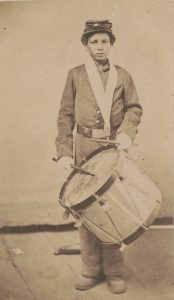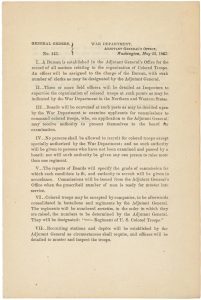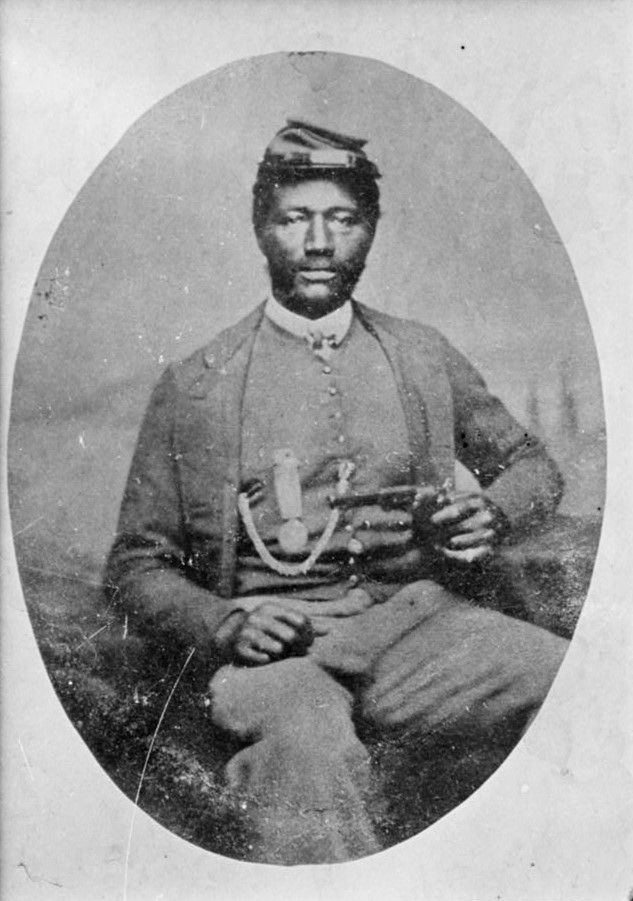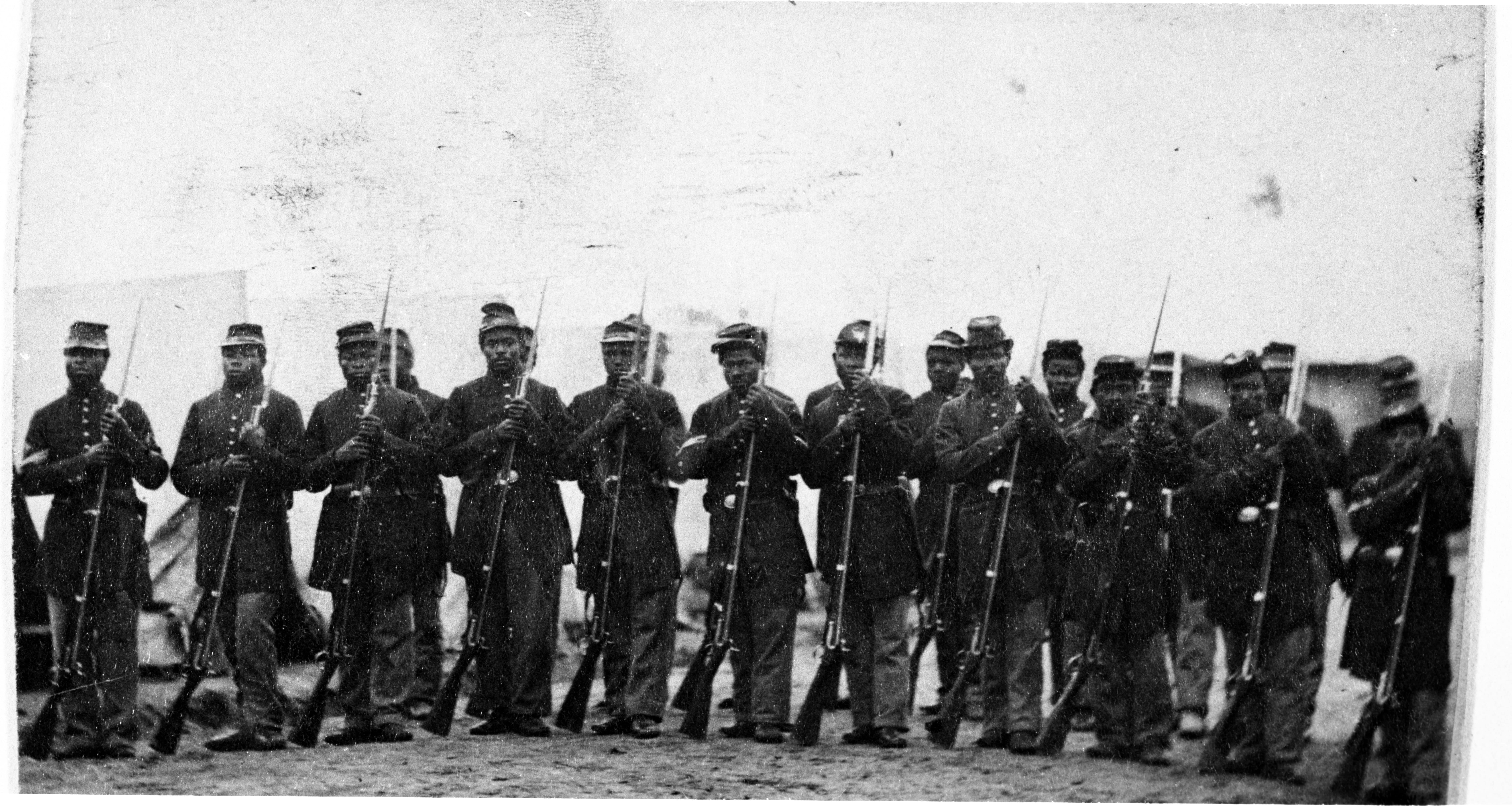U.S. Colored Troops at Port Hudson, Louisiana circa 1864. National Archives and Records Administration
A Forgotten History
African American service in the United States military began long before the U.S. Civil War in 1861. African American men served in state and private militias from the outset of the American Revolution. In 1778, the 1st Rhode Island Regiment became the first majority-Black regiment in the nation’s history, and participated in the Siege of Boston, the Battle of Rhode Island, and the battle of Yorktown before war’s end. In the War of 1812, African American Soldiers fought alongside other units in the successful defense of New Orleans in 1815, and repulsed British attacks elsewhere while serving in both integrated and segregated units throughout the volunteer Army. After the war, state and federal laws prohibited African Americans from continuing their valued service in the military. Racial prejudice and a growing concern over slave rebellions not only prevented African American men from enlisting, but also suppressed the ability of African American veterans to receive proper recognition for their service.

A Drummer in the 78th Regt., U.S. Colored Infantry circa 1861-1865. National Archives and Records Administration
Early Doubts
Even after the outbreak of the Civil War in April 1861, the Lincoln administration and state governors were reluctant to recruit African Americans for service. For over a year, as Union losses mounted following the Battle of Bull Run and the Peninsula Campaign, the federal and state governments refused to enlist thousands of eager African Americans. However, several Union generals took matters into their own hands. In the east, Maj. Gen. Benjamin F. Butler took command of Union forces near Fort Monroe, Virginia. In May 1861, three escaped enslaved men arrived in his camp seeking their freedom. Butler labeled them as “contraband” of war, meaning that since the Confederacy viewed these men as property, the Union Army had just as much right to their use as the enemy. Over the next several months, 900 more escaped enslaved men and their families arrived at Fort Monroe. The Lincoln administration, worried about losing the support of the pro-Union slave-holding states Missouri, Kentucky, and Maryland, denounced the act. Despite the official policy of refusing African Americans the opportunity to fight for their freedom, two more generals soon joined Butler. Maj. Gen. John C. Fremont in Missouri and Maj. Gen. David Hunter in South Carolina proclaimed all enslaved persons in Union-held territory in Georgia, Florida, and South Carolina free and able to enlist. Again, the Lincoln administration refuted the generals’ authority and banned the practice.
In 1862, as the war became increasingly bloody, official policy shifted toward enabling African Americans the right to fight for themselves. Substantial numbers of African Americans, led by African American intellectuals and abolitionists, repeatedly lobbied the government until their pleas could no longer be ignored. With Union forces depleted almost 40% due to deaths, wounds, illness, and desertion, and with many initial enlistments ending, the Lincoln administration relented in the summer of 1862. Congress, with President Abraham Lincoln’s support, passed the Second Confiscation Act and Militia Act on July 17, 1862. These acts freed any enslaved person who left a “disloyal” owner in the rebellious states and allowed the president to “employ as many persons of African descent as he may deem necessary.” However, the acts fell short in two significant ways. First, it limited enlisted African Americans to menial tasks, auxiliary roles, and support positions away from combat. Second, it limited the pay of enlisted African Americans to 30% less than their white counterparts in the Army, a discrepancy that went unfixed for over two years. Despite the limitations of the government’s policy, change soon came to the Union Army.

General Order 143: Creation of the U.S. Colored Troops, May 22, 1863. National Archives and Records Administration
The First Regiments
Almost immediately after the two acts, Butler, then stationed in New Orleans, raised several regiments of Louisiana Native Guards and renamed them the Corps D’Afrique, one of the first official U.S. Army regiments of color. Other officers soon followed suit, with state militias from Massachusetts and Union-occupied portions of South Carolina forming multiple regiments each within weeks. The initial Emancipation Proclamation, issued in September 1862 took effect on January 1st, 1863, and officially freed all enslaved persons in Confederate-held territory while increasing the allotment of African American enlistment to 200,000 Soldiers. While the political climate of America finally relented to the induction of African Americans into the Union Army, the process remained haphazard at best. States formed regiments of different sizes, with varying equipment and barely any leadership. In May 1863, the United States War Department issued General Order 143 to standardize the enlistment and training of African American Soldiers under the control of official War Department policy. Two years after the first shots of the war were fired, the United States Colored Troops (USCT) were born.
African American leaders such as Frederick Douglass set to work helping the government raise Black regiments immediately after their eligibility. Soon, over 166 regiments began training in various camps spread throughout the North and South. However, racial prejudice still pervaded the country and, with the exception of Butler’s Louisiana troops, Civil War-era laws still barred African American men from becoming officers in their own regiments. Some white abolitionists volunteered to lead the new formations, but others offered to lead African American Soldiers merely to advance their own careers. Thus, the leadership of many USCT varied to a considerable degree, with noticeable effect on the morale and training of the enlisted men. Despite sometimes poor leadership, lower pay, and still-pervasive racial prejudice, the USCT soon proved itself worthy of equal praise in combat.
Combat Tested
One of the first engagements in the Civil War involving large numbers of USCT occurred along the St. Marys River, near the Florida-Georgia border. Under the command of Col. T.W. Higginson, the 1st South Carolina Volunteer Regiment performed a series of daring raids and ambushes alone several hundred miles behind enemy lines. Higginson reported that while a previous expedition led by white men from the North failed, his unit’s success relied upon the fervor and local knowledge of the freedmen in his unit. After the expedition, Higginson became one of the leaders to recognize that “No officer in this regiment now doubts that the key to the successful prosecution of this war lies in the unlimited employment of black troops… It would have been madness to attempt [the battle], with the bravest white troops, what I have successfully accomplished with the black ones.” Union leaders now recognized that given equal leadership, training, and equipment, African American Soldiers performed bravely under withering fire and austere conditions.
Success within the USCT was not limited to the minor skirmishing of Higginson’s raid. In May 1863, the 1st and 3d Corps D’Afrique attacked the Confederate stronghold of Port Hudson, Louisiana. After previous units failed to break through the Confederate defenses, Brig. Gen. William Dwight ordered the African American units to attack a strong point along the western edge of the Confederate line. The units crossed a short bridge, bordered on their right by the Mississippi River and on their left by entrenched enemy sharpshooters and cannons. The Louisiana troops, led by freedman Capt. Andre Cailloux, assaulted the position under withering fire. Cailloux, wounded twice, led his soldiers until mortally wounded by a cannon ball just outside the breastworks. The assault withdrew and successfully laid siege to the Confederate garrison until it’s surrender six weeks later. Cailloux’s gallantry under fire became a rallying cry for African American and white Soldiers alike throughout the rest of the war.

USCT Soldiers from Louisiana defend a levee during the Battle of Milliken’s Bend, June 7, 1863. Public Domain
Almost simultaneously, four other regiments of Louisianan African Americans performed another brave action, this time at the Battle of Milliken’s Bend on June 7, 1863. Despite being only recently formed and poorly trained, the 8th, 9th, 11th, and 13th Louisiana Infantry Regiments faced a disciplined brigade of Texas Confederates on top of a reinforced levee. The Confederates attacked the Union defenders at sunrise, scattering every Union regiment except the USCT regiments. As the USCT Soldiers fought in hand-to-hand combat, Union gunboats soon appeared on the river behind them. The naval guns forced the Confederates to retreat, and the tenacious USCT regiments retained the battlefield, but at high cost. Of the 652 Union casualties, over 90% were from the USCT units.
In the eastern theater, the 54th Massachusetts Infantry Regiment earned yet another outstanding reputation for the USCT in its assault on Fort Wagner, South Carolina, on July 18, 1863. Despite overwhelming odds and difficult terrain, the 54th Massachusetts scaled the outer walls of the fort before withdrawing with significant casualties. For his actions at Fort Wagner, Sgt. William Carney was awarded the first of 16 Medals of Honor given to African Americans in the Civil War. USCT regiments went on to fight in over 40 other major engagements and hundreds of minor skirmishes before the final emancipation of all enslaved people on June 19, 1865.
Unique Challenges
Throughout the war, USCT regiments faced a danger that their white peers did not: re-enslavement or execution. Official Confederate policy refused to recognize African Americans as lawful combatants. Any captured African American Soldiers or their white officers were subject to harsh treatment or execution. Furthermore, Confederate generals refused to exchange any African American prisoners of war, subjecting them to indefinite internment in prison camps with mortality rates near 50%. This Confederate policy forced Lincoln to issue an official order threatening reprisals should African Americans or their officers be treated unlawfully. While Lincoln’s threat did reduce the rate of mistreatment, several atrocities still occurred. In April 1864, Confederate soldiers under the command of Maj. Gen. Nathan B. Forrest executed wounded and captured USCT men after the battle of Fort Pillow, in Henning, Tennessee.

Sgt. James H. Harris, 38th USCT, Awarded the Medal of Honor for actions at Chaffin’s Farm and New Market Heights, VA on September 29, 1864. Library of Congress
While the exact number of African Americans who served in the USCT is still unknown, most estimates place the full number at over 180,000 volunteers. The USCT units suffered significant casualties throughout the war, with 38,000 to 43,000 dying in combat, of wounds, or due to disease in a period of just over two years. Writing to Lincoln, Secretary of War Edwin Stanton admired the fighting capacity of the African Americans, refuting the common prejudice of his day by declaring “Many persons believed, or pretended to believe, and confidentially asserted, that freed slaves would not make good soldiers; they would lack courage, and could not be subjected to military discipline. Facts have shown how groundless were these apprehensions.” The actions of the USCT during the Civil War lent credence to Frederick Douglass’ claim that “Once let the black man get upon his person the brass letter, U.S., let him get an eagle on his button, and a musket on his shoulder and bullets in his pocket, there is no power on earth that can deny that he has earned the right to citizenship.” The 14th Amendment, passed after the Civil War ended, finally recognized African American citizenship. African Americans continued their service in the U.S. Army after the war, beginning with the creation of the “Buffalo Soldiers.”
Jacob M. Henry
Graduate Historic Research Intern
Sources
“The United States Colored Troops.” American Battlefield Trust. Accessed February 4, 2022. https://www.battlefields.org/learn/articles/united-states-colored-troops.
“Black Soldiers in the U.S. Military During the Civil War.” National Archives. Accessed February 2, 2022. Last modified September 1, 2017. https://www.archives.gov/education/lessons/blacks-civil-war.
Dobak, William A. Freedom by the Sword the U.S. Colored Troops, 1862-1867. Washington, D.C: Center of Military History, 2011.
Higginson, Thomas Wentworth. Army Life in a Black Regiment, and Other Writings. New York: Penguin Books, 1997.
Additional Reading
Blight, David W. A Slave No More: Two Men Who Escaped to Freedom : Including Their Own Narratives of Emancipation. 1st Mariner books ed. Boston: Mariner Books, 2009.
McPherson, James M. The Negro’s Civil War: How American Blacks Felt and Acted During the War for the Union. 1st Vintage Civil War library ed. New York: Vintage Books, 2003.

